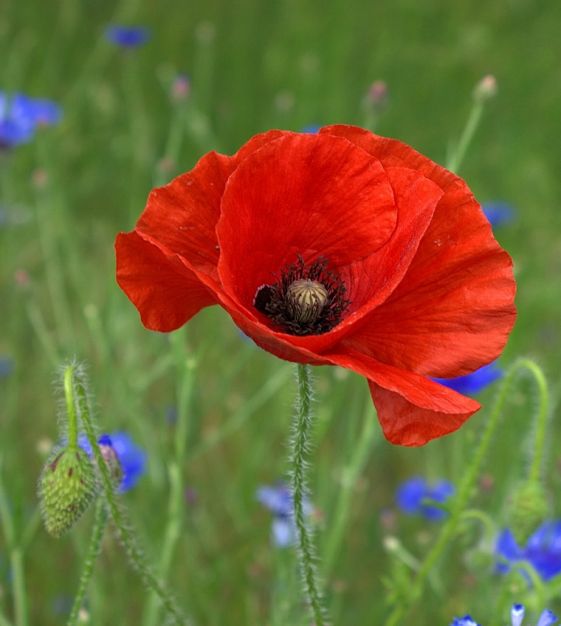Back to Top
Flanders Field Poppy
Papaver rhoeas. The Flanders Field Poppy is a universal symbol of remembrance, inspired by the vast numbers of them that bloomed on the devastated battlefields of Belgium and France after World War I. In the garden, it adds a vivid splash of red to informal tableaux. Its waving wands of nodding fuzzy buds, delicate tissue-paper flowers, and tiny pepper-shaker seed pods are delightful from June through September. Annual. Summer flowering. Height: 2' to 3'. Average seed life: 4 to 5 years.
One packet of about 4,000 seeds
One packet of about 4,000 seeds
- Buy 10 for $4.55 each and save 10%
- Buy 50 for $3.80 each and save 25%
- Information
- Gardening Tips
Adorning gardens around the world, Poppies are available in a wide range of species, unique colors and sizes. Poppies are best sown directly into your garden beds in late fall or winter, or early spring at the very latest. Their seeds appreciate the stratification that winter provides, and they also need chilly temperatures to germinate in spring. Poppies also abhor root disturbance, so transplanting seedlings grown indoors will likely result in failure. (If you must start indoors for transplant out, use individual cells or pots~not flats.)
Once you've selected your Poppy seeds, choose the spot in which you'd like them to grow. It's essential that Poppies be grown in lean, well-draining soil, though Oriental Poppies are an exception--they prefer richer soil. For all other Poppies, simply clear the spot of any lingering weeds or debris, scratch the soil up lightly with a rake, and sprinkle the seeds on the surface. Poppy seeds are small and dark~mixing the seeds with sand will make it easier to sow them evenly and to see where you've sown them. Poppy seeds need light to germinate, so don't bother covering them. Fall rains and winter snow cycles will nestle them into the soil perfectly. In spring, once the seedlings begin to pop up, thin them to about 6" to 10" apart. Bee friendly. Deer resistant.
Average seed life: 4 to 5 years.
Average seed life: 4 to 5 years.
Adorning gardens around the world, Poppies are available in a wide range of species, unique colors and sizes. Poppies are best sown directly into your garden beds in late fall or winter, or early spring at the very latest. Their seeds appreciate the stratification that winter provides, and they also need chilly temperatures to germinate in spring. Poppies also abhor root disturbance, so transplanting seedlings grown indoors will likely result in failure. (If you must start indoors for transplant out, use individual cells or pots~not flats.)
Once you've selected your Poppy seeds, choose the spot in which you'd like them to grow. It's essential that Poppies be grown in lean, well-draining soil, though Oriental Poppies are an exception--they prefer richer soil. For all other Poppies, simply clear the spot of any lingering weeds or debris, scratch the soil up lightly with a rake, and sprinkle the seeds on the surface. Poppy seeds are small and dark~mixing the seeds with sand will make it easier to sow them evenly and to see where you've sown them. Poppy seeds need light to germinate, so don't bother covering them. Fall rains and winter snow cycles will nestle them into the soil perfectly. In spring, once the seedlings begin to pop up, thin them to about 6" to 10" apart. Bee friendly. Deer resistant.
Average seed life: 4 to 5 years.
Average seed life: 4 to 5 years.




